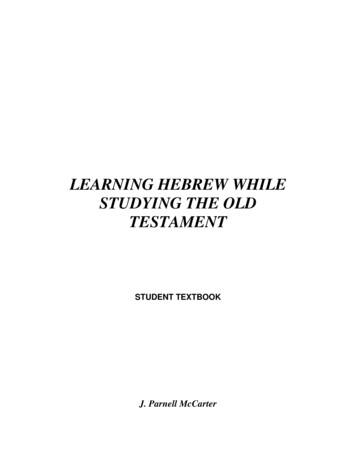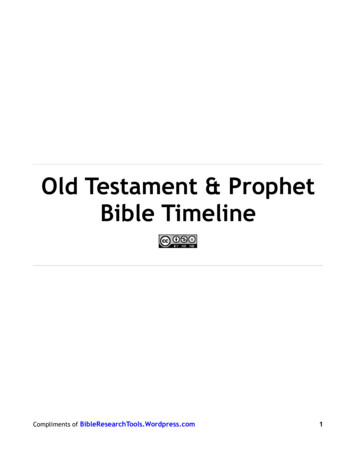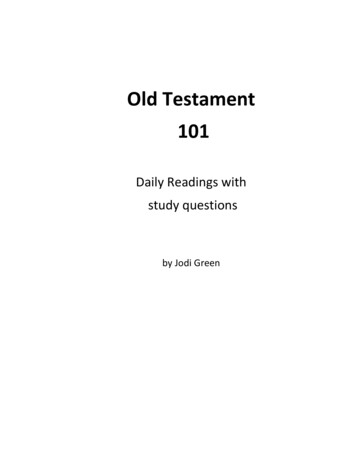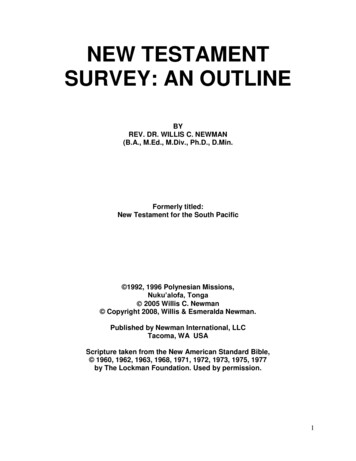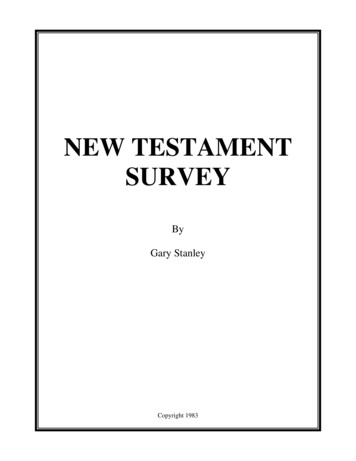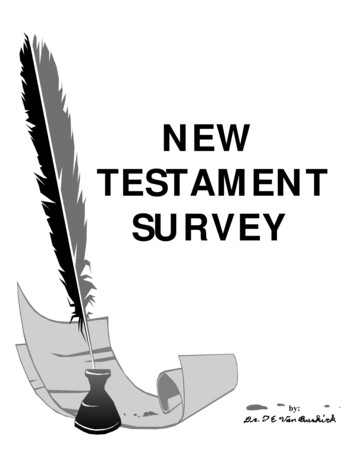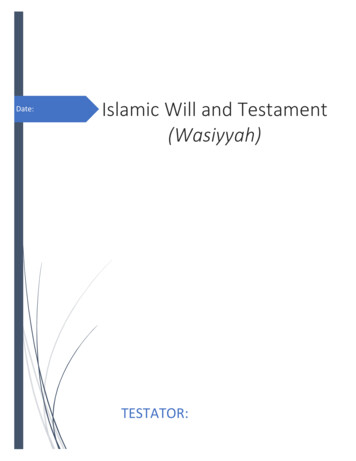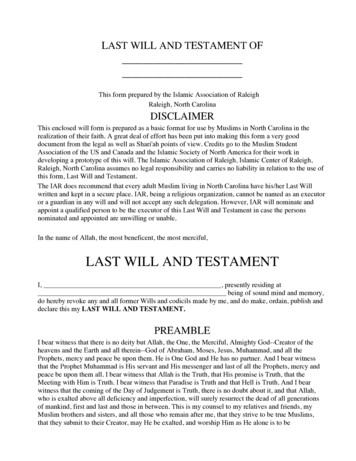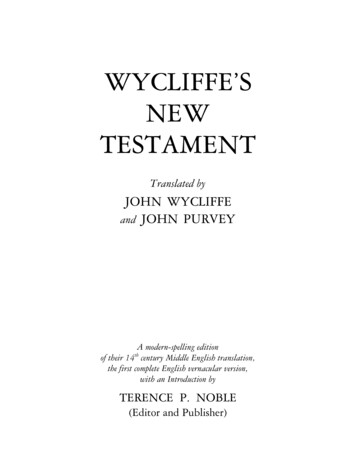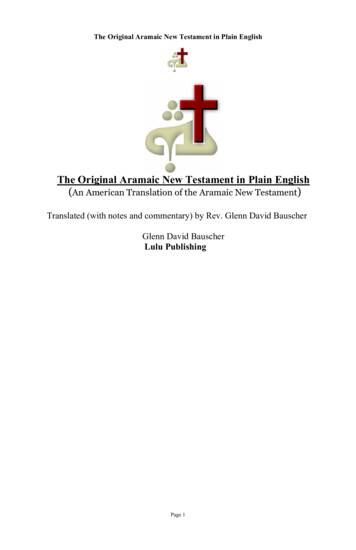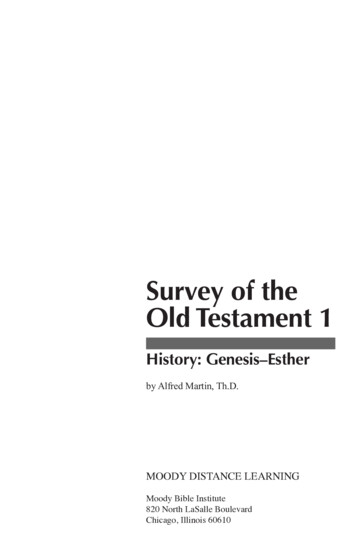
Transcription
Survey of theOld Testament 1History: Genesis–Estherby Alfred Martin, Th.D.MOODY DISTANCE LEARNINGMoody Bible Institute820 North LaSalle BoulevardChicago, Illinois 60610
1961 by THE MOODY BIBLE INSTITUTE OF CHICAGORevised 1965, 1995, 2004, 2011, 2012, 2014.Edited by Kelli Fleck.All rights reserved. No part of this course may be reproduced inany form without written permission from the publisher, exceptin the case of brief quotations embodied in critical articles andreviews.All Scripture quotations, unless indicated, are taken fromtheHOLY BIBLE, NEW INTERNATIONAL VERSION. Copyright 1973, 1978, 1984 International Bible Society. Used bypermission of Zondervan Bible Publishers.All rights reserved.
ContentsDescription 03Requirements and Procedures 05Academic Policies and Information 07Lesson 1What and Why 09Lesson 2Genesis 17Lesson 3Exodus 29Lesson 4Leviticus 45Lesson 5Numbers 53Lesson 6Deuteronomy 61Lesson 7Joshua 73Lesson 8Judges and Ruth 81Lesson 91 and 2 Samuel 89Lesson 101 and 2 Kings 101Lesson 111 and 2 Chronicles 109Lesson 12Ezra, Nehemiah, Esther 117Quiz Answer Key Moody Distance Learning / Survey of the Old Testament 11291
DescriptionTo see the Scriptures as a whole is not only crucial to a goodunderstanding of the Bible; it can also be an exciting experience.This lesson material is based in part on a former course by Dr.James M. Gray. Exams, maps, and charts were prepared byJohn Phillips. This lesson material is the first in a series of three,designed to take you completely through the Bible. Survey of the Old Testament I: Genesis—Esther Survey of the Old Testament II: Job—Malachi Survey of the New Testament: Matthew—RevelationCourse ComponentsYour course consists of two components – this study guide and anenvelope containing four color-coded answer sheets.The Study Guide The study guide contains all of the lessons and exams for thiscourse. There is a self-check quiz after every lesson (true andfalse questions and/or multiple choice). An exam follows Lesson3, 6, 9, and 12.The Scantron Answer Sheets The color-coded Scantron answer sheets come with your course.These correspond to the exams in your study guide. Please usethese sheets to mark your answers for each exam. Use only a #2lead pencil to mark your answers. (Because these tests areelectronically graded, ink or harder leads are not acceptable.)Moody Distance Learning / Survey of the Old Testament 13
Requirements and ProceduresRequirementsIn order to receive credit, the four exams must be completed withan overall average grade of 70% or better. A Grade Record Sheet isprovided at the beginning of your study guide to help you keep trackof your standing in this course.ProceduresPlease follow the procedures listed for completing the lessons andexams in this course. As you complete each exam, mail the answersheet to Moody Distance Learning, 820 N. LaSalle Boulevard,Chicago, IL 60610-3284, along with a self-addressed, stampedenvelope for the return of your graded answer sheet. If you prefer, youmay send multiple exams in one envelope. We request that you use theenvelopes provided for this purpose.The Lessons Read the study guide at a time when you can concentrate. Pick atime of the day you are most likely to be alert and relativelyuninterrupted.Read with a pencil or pen in hand. You will want to underlinewords or phrases, even sentences, for later reference.The Exams When you have completed all of the lessons that an examcovers, go back and review the material in the study guide. Youmay want to prepare by writing out your own outline of thematerial covered. The outlines will help you focus on the majortruths discussed in each lesson.All exams are objective in nature and utilize the special answersheets, or Scantron forms, provided with this course.Moody Distance Learning / Survey of the Old Testament 15
When taking the exam, please follow these instructions: It is important that you select the proper answer sheet for eachexam. The answer sheet are as follows:Exam 1 is blueExam 2 is greenExam 3 is redExam 4 is tan 6Fill in the blanks at the top of your answer sheet. Please write legibly.We encourage you not to refer to your textbook or notes of anykind while taking the exam.Please use a #2 lead pencil to mark your answers. Fill in the spacesdarkly and completely – be sure to erase any mistakes thoroughly.Mail your answer sheet to Moody Distance Learning along witha self-addressed, stamped envelope for the return of your gradedanswer sheet. If you prefer, you may send multiple exams of thesame course in the same envelope. Please use the envelopeprovided with the course, for this purpose. Please do not sendthe pages of the exam from the study guide.When you receive your graded answer sheet from Moody DistanceLearning, record your grade in the appropriate box on the GradeRecord Sheet. Please mail in the Grade Record Card with your lastexam(s). Keep your exams for future reference.Moody Distance Learning / Survey of the Old Testament 1
Lesson 1 What and WhyWhat and WhyIt is very important to have a clear picture of the Bible in itsentirety before attempting a detailed study of its various parts. In thislesson, we will consider the aim of our study and the scope of thelessons that follow.The Bible is the Word of God. Consequently, it is essential that welearn what is in it and what it means. We must know the content of thebook before we can know its interpretation. In other words, we haveto know what the Bible says before we can understand what the Biblemeans. Our aim should be at least fourfold. To get a mastery of the factual content of the Bible To recognize the unity of the Bible, noting the relationshipsof the various books to one another and to the Bible as awhole To see the Lord Jesus Christ in all the Scriptures To make practical application to our own livesThe Theme and Purpose of the BibleThe Bible does not claim to be the complete history of the universeor even of the human race. Rather, it is the history of redemption,illustrating the outworking of God’s purpose in saving humanitythrough His Son, the Lord Jesus Christ. Because of this, we shouldexpect to see the Lord Jesus in all parts of the Bible—in the OldTestament as well as in the New. After His resurrection from the dead,Jesus said to His disciples, “This is what I told you while I was stillwith you: Everything must be fulfilled that is written about me in theLaw of Moses, the Prophets and the Psalms” (Luke 24:44).The Structure of the BibleIt is easy to see that the Bible falls into two main divisions—the OldTestament and the New Testament. The word testament, as it is usedMoody Distance Learning / Survey of the Old Testament 19
here, means a covenant or an agreement. The Old Testament is God’scovenant with humanity before the coming of the Lord Jesus Christinto the world. The New Testament is God’s covenant with humanitythrough Jesus Christ.Interestingly, the Old Testament is three times as long as theNew. Since God has given this large amount of material in the OldTestament, we can rightly infer that He must want His people to studyit. It is impossible to understand many of the doctrinal references in theNew Testament without knowing a good deal about the Old.The Old Testament contains 39 books written over a period of manyhundreds of years, from the time of Moses (approximately 1500 b.c.)to the last book of the Old Testament, Malachi (approximately 400b.c.). We usually speak of these books as falling into four categories:books of the Law, books of history, books of poetry, and books ofprophecy. The books of prophecy are often further divided into theMajor Prophets and the Minor Prophets. A convenient memory deviceis the use of the figures 5, 12, 5, 5, 12—that is, five books of the Law,twelve books of history, five of poetry, five of the Major Prophets, andtwelve of the Minor Prophets.The New Testament can be divided into books of history, books ofteaching (the Epistles), and one book of prophecy; that is, five booksof history (the four Gospels and the book of Acts), twenty-one epistles(from Romans to Jude), and the single book of prophecy (Revelation).This survey is divided into three volumes, two of which will focuson the Old Testament and one on the New. In this first volume we studythe books of the Law and the books of history–seventeen books in all.The entire Old Testament, lengthy as it is, is anticipatory. It looksforward to the coming of the promised Redeemer into the world. Wecould write over the whole of it, “He is coming; He is coming; Heis coming!” From the very first prophecy of the Lord Jesus Christ inGenesis 3:15, and on through the entire Old Testament, the definiteline that is followed is the line of this promised Redeemer.We need to understand the unity of the Word of God, a unity inspite of variety. Here are 66 books, produced by about forty differentwriters over a period of many hundreds of years, and yet manifestingincredible harmony, centering around one person—the Lord JesusChrist. The Bible declares itself to be from God. “All Scripture is God10Moody Distance Learning / Survey of the Old Testament 1
breathed and is useful for teaching, rebuking, correcting and trainingin righteousness” (2 Timothy 3:16). The men who wrote the Biblewere spokesmen for God, as the Bible itself tells us: “For prophecynever had its origin in the will of man, but men spoke from God as theywere carried along by the Holy Spirit” (2 Peter 1:21).As we begin the study of this lesson material, it is important that weknow what it is we are studying. The word Bible comes from a Greekword which originally meant “book.” Through usage, this came to beregarded as a plural form, translated “books.” Of course, either thesingular or the plural is appropriate. Undeniably, the Bible is a singlebook, distinct from all other books; at the same time, it is a collectionof books, numerous writings forming one unified whole.The most common term the Bible uses for itself is the Scriptures.This means “writings.” Sometimes the adjective holy is joined with thisword; the Holy Scriptures are the writings that are set apart, distinctfrom all other writings—the writings that came from God.The study of the Bible is both like and unlike the study of otherliterature. It is like other studies in that it requires personal diligenceand application. It is unlike the study of human literature in that itincludes a spiritual as well as an intellectual element. The Holy Spiritis the author of this Book and He must be its interpreter as well. Anunsaved person can read and study the Bible but cannot actuallyunderstand its spiritual content because he or she does not have theindwelling Holy Spirit. “The man without the Spirit does not acceptthe things that come from the Spirit of God, for they are foolishnessto him, and he cannot understand them, because they are spirituallydiscerned” (1 Corinthians 2:14). Therefore, the first qualification forreal Bible study is that the student be born again through faith in theLord Jesus Christ (John 3:3, 7, 16).Even believers, however, can be hindered in their understandingof the Bible if they are not living in right relationship to the HolySpirit. So, a second qualification is a surrendered life. Paul told thebelievers at Corinth that humanity is divided into three groups as totheir understanding of the Word of God. The first is the natural man,who is unsaved and cannot receive the things of God. In contrast, thereis the spiritual man, a believer who is correctly related to the HolySpirit and, therefore, able to discern all things. In between is the carnalMoody Distance Learning / Survey of the Old Testament 111
man, a believer who is not yielded to the Holy Spirit and, therefore, ababe in Christ (1 Corinthians 2:14–3:4).Yielded Christians, even though they may not have muchformal education and may have only a limited intellectual capacitycan, nevertheless, make great progress in their understanding ofthe Word of God because they know the Teacher and have dailyfellowship with Him.The Theme of the BibleThe general theme of the Bible, as we have noted, is redemptionthrough the Lord Jesus Christ, the Son of God. After His resurrectionfrom the dead, on the walk to Emmaus with two disciples, Jesus began“with Moses and all the prophets” and “explained to them what wassaid in all the Scriptures concerning himself” (Luke 24:27). Of course,this is true of the New Testament as well. That the message of the Bibleis indeed Christ in His person and work is also shown in the words ofour Lord to the Pharisees. “You diligently study the Scriptures becauseyou think that by them you possess eternal life. These are the Scripturesthat testify about me, yet you refuse to come to me to have life” (John5:39, 40). It is possible to know the factual content of the Scriptureswithout ever knowing the person to whom the Scriptures point.The Incompleteness of the Old TestamentEvery part of the Word of God is perfect because it is the Word ofGod. But the Old Testament by itself, as long as it is, is incomplete. Wehave seen that it is anticipatory of the Lord Jesus Christ, and the NewTestament speaks of the fulfillment of that expectation. “But when thetime had fully come, God sent his Son, born of a woman, born underlaw, to redeem those under law, that we might receive the full rights ofsons” (Galatians 4:4, 5). If we had only the Old Testament, we wouldfeel that the story is far from complete. From beginning to end, it is abook of promise, looking forward to something not yet fulfilled.How the Story UnfoldsGod is the God of history, and much of the Bible story grows outof His dealings in history with His chosen people. Beginning with a12Moody Distance Learning / Survey of the Old Testament 1
brief review of early human history, the story line of the Bible soonfocuses on Abraham, Isaac, and Jacob—the founding fathers ofthe Hebrew race. The descendants of Jacob, known as the childrenof Israel, grew to nationhood in Egypt, eventually settled in thepromised land of Canaan, and there became a powerful people.Their early history in the land, however, was marked by constantapostasy. God had given them the Law, the tabernacle, the Aaronicpriesthood, and a rich heritage through the ministry of Moses. Butthe Israelites stubbornly ignored God’s warnings against idolatryand soon became involved in the vile religious orgies of theirheathen neighbors. For the purpose of judgment, God allowed themto be delivered again and again into the hands of their foes, andthese oppressions were only temporarily relieved by the occasionalappearance of godly judges.The nation finally became a monarchy. Saul’s disastrous reignwas followed by the founding of the royal house of David, the“man after God’s own heart,” who greatly extended Israel’s bordersand brought peace to the land. David and his son Solomon made animportant contribution to the poetical sections of the Old Testament.After a brief period of prosperity and power, however, the unitedkingdom fell apart, mainly because Solomon’s indulgencesreintroduced idolatry to the nation. The kingdom was split in twoafter Solomon’s death (931 b.c.). Two of the tribes remained true tothe throne of David, but the other ten set up a rival monarchy in thenorth, with Samaria eventually becoming its capital. The southernkingdom, with Jerusalem as its capital, was known as Judah. (InMatthew 1 the human ancestry of the Lord Jesus is traced throughthe line of the kings of Judah, right back to David.) The northernkingdom was known as Israel, or sometimes as “Ephraim,” itsdominant tribe.The history of the divided kingdom was turbulent. Not a singlegood king sat on the throne of Israel. Eventually the northernkingdom fell to the evil Assyrians, and its people were carried awayinto captivity (722 b.c.). The kingdom of Judah outlasted Israel forabout 135 years. Some of Judah’s kings were good and some bad,but apostasy and idolatry ultimately prevailed, and the Babyloniansbecame God’s instrument to punish Judah. Jerusalem was sacked,the magnificent temple of Solomon was destroyed, and the peoplewere deported to Babylon (586 b.c.).Moody Distance Learning / Survey of the Old Testament 113
Eventually the Babylonian Empire was replaced on the stage ofhistory by the Persian Empire, and the Jews were given permission toreturn to Palestine. Under great difficulties, the small remnant returned(539 b.c.) and rebuilt Jerusalem and the temple. The entire period of thedivided kingdom, the Captivity, and the return from captivity gave riseto the prophets, whose books form a large part of the Old Testament.The New Testament opens on Israel with an intensely nationalisticremnant in the land but with a large Jewish population dispersed inall parts of the world. Christ was born in the zenith of Roman power.He was crucified by the Romans at the insistence of the Jews, whohad rejected Him and His claims to be their King and Messiah. Hisresurrection and ascension and the coming of the Holy Spirit on theDay of Pentecost introduced a new era—the era of the church. Peterand Paul dominated the early history of the church, taking the gospelto both Jews and Gentiles. Peter concentrated mainly on Jerusalemand Palestine, and Paul, after his spectacular conversion, became theApostle to the Gentiles and the most famous missionary of the church.Much of the New Testament is comprised of letters written by theapostles to churches and converts throughout the Roman Empire—letters intended to encourage, instruct, and reprove. The Bible closeson a note of prophecy, anticipating the second coming of Christ, thefinal fulfillment of all outstanding prophecies, and the consummationof all God’s purposes with man.One good way of fixing in your mind the history of the Bible is tothink of it in terms of patriarchs, great leaders, kings, foreign rulers,Christ, and the church.14Moody Distance Learning / Survey of the Old Testament 1
Self-Check Quiz 1This self-check test will help you evaluate what you have learned inthe preceding lesson and will also help you prepare for upcomingexam. Indicate your answer to each of the following questions.1. True or False: We must know the content of a book before we canknow its interpretation.2. True or False: The Bible is a complete history of the universe.3. True or False: It is possible to know the factual content of theScriptures and still remain a stranger to Christ.4. True or False: The Old Testament is of little value, now that wehave the New Testament.5. True or False: The entire Bible is inspired by the Holy Spirit6. Which of the following Scripture references can be used to provethat the Bible is inspired by God?a. 2 Timothy 3:16b. Titus 2:15c. James 1:22d. John 3:367. Which of the following names or events came first, according tothe historical order given in the lesson material?a. King Davidb. Abrahamc. Judah goes into captivityd. Israel goes into captivity8. The first qualification essential to real Bible study is:a. A good educationb. Ability to name the books of the Bible from memoryc. A careful reading of the Bible from cover to coverd. New birth through faith in the Lord Jesus Christcontinued on next pageMoody Distance Learning / Survey of the Old Testament 115
9. The second qualification essential to real Bible study is:a. A taste for good literatureb. A teachable spiritc. A life surrendered to the Spirit of Godd. An alert mental attitude10. Which figure gives the correct number of books in each of thefollowing main divisions of the Bible?a. Old Testament history: 21b. New Testament history: 5c. Old Testament Law: 4d. New Testament prophecy: 2Refer to the answer key at the end of this study guide. Please do notsend your answers to Moody Distance Learning.16Moody Distance Learning / Survey of the Old Testament 1
To recognize the unity of the Bible, noting the relationships of the various books to one another and to the Bible as a whole To see the Lord Jesus Christ in all the Scriptures To make practical application to our own lives The Theme and Purpose of the Bible The Bible

